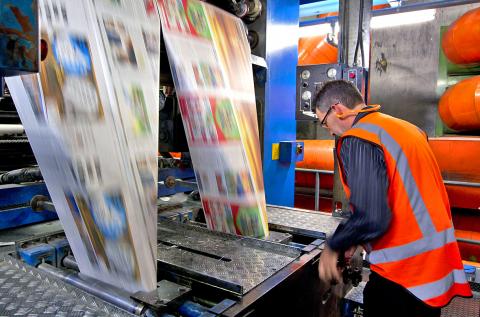Facing declining revenues and changing reader habits, New Zealand’s two main newspaper groups yesterday said they were discussing a merger that could end decades of competition and result in hundreds of job losses.
Under the proposal, a single company would publish most of New Zealand’s metropolitan newspapers. That would mean readers from Auckland to Invercargill would end up reading many of the same stories on politics, business and sports.
If approved by regulators, the merger would combine the New Zealand newspapers, radio stations and Web sites owned by Fairfax Media and APN News & Media. Both companies, which are based in Australia, are seeking to divest their New Zealand assets and form them into a new, listed company.

Photo: New Zealand Herald via AP
APN publishes the nation’s biggest daily newspaper, the New Zealand Herald, while Fairfax publishes the next largest dailies, the Dominion Post and the Press. The companies also own two of the largest news Web sites, stuff.co.nz and nzherald.co.nz.
The companies say their businesses are complementary and the proposed merger would allow them to improve offerings to readers and advertisers.
However, unions and observers worry about the potential loss of jobs and diverse viewpoints.
The move represents the latest retrenchment in Australia and New Zealand, where many media firms are struggling to adjust to a rapidly changing landscape.
Gavin Ellis, a media commentator and former editor-in-chief of the New Zealand Herald, said the upside of the proposed merger was that it would allow the newspapers to survive longer than if the companies tried to go it alone.
The downside was the reduction in the variety and voices of journalists and opinion columnists, he said.
The two companies have a combined New Zealand workforce of about 3,000. Ellis said there could potentially be hundreds of job losses as the groups eliminated duplication in everything from political coverage to sales.
To complete the merger, APN plans to separate its New Zealand holdings and list them on the New Zealand and Australian stock exchanges under the name NZME. Fairfax would then fold its New Zealand assets into NZME.
APN chief executive Ciaran Davis said the two companies had signed a memorandum of understanding.
The merger will need approval from New Zealand’s Commerce Commission, which is tasked with ensuring business monopolies do not develop.
Commission spokesman Christian Bonnevie said it had not yet received an application, which would typically take between six weeks and one year to process depending on its complexity.
In a trading update yesterday, APN said market conditions have been challenging in New Zealand and its revenues were down 10 percent in the first quarter.
Fairfax Media, Australia’s second-largest newspaper publisher, has laid off about 2,000 employees, or about one-fifth of its staff, since 2012 and erected pay walls for its flagship papers in a bid to boost revenue.

Intel Corp chief executive officer Lip-Bu Tan (陳立武) is expected to meet with Taiwanese suppliers next month in conjunction with the opening of the Computex Taipei trade show, supply chain sources said on Monday. The visit, the first for Tan to Taiwan since assuming his new post last month, would be aimed at enhancing Intel’s ties with suppliers in Taiwan as he attempts to help turn around the struggling US chipmaker, the sources said. Tan is to hold a banquet to celebrate Intel’s 40-year presence in Taiwan before Computex opens on May 20 and invite dozens of Taiwanese suppliers to exchange views

Application-specific integrated circuit designer Faraday Technology Corp (智原) yesterday said that although revenue this quarter would decline 30 percent from last quarter, it retained its full-year forecast of revenue growth of 100 percent. The company attributed the quarterly drop to a slowdown in customers’ production of chips using Faraday’s advanced packaging technology. The company is still confident about its revenue growth this year, given its strong “design-win” — or the projects it won to help customers design their chips, Faraday president Steve Wang (王國雍) told an online earnings conference. “The design-win this year is better than we expected. We believe we will win

Chizuko Kimura has become the first female sushi chef in the world to win a Michelin star, fulfilling a promise she made to her dying husband to continue his legacy. The 54-year-old Japanese chef regained the Michelin star her late husband, Shunei Kimura, won three years ago for their Sushi Shunei restaurant in Paris. For Shunei Kimura, the star was a dream come true. However, the joy was short-lived. He died from cancer just three months later in June 2022. He was 65. The following year, the restaurant in the heart of Montmartre lost its star rating. Chizuko Kimura insisted that the new star is still down

While China’s leaders use their economic and political might to fight US President Donald Trump’s trade war “to the end,” its army of social media soldiers are embarking on a more humorous campaign online. Trump’s tariff blitz has seen Washington and Beijing impose eye-watering duties on imports from the other, fanning a standoff between the economic superpowers that has sparked global recession fears and sent markets into a tailspin. Trump says his policy is a response to years of being “ripped off” by other countries and aims to bring manufacturing to the US, forcing companies to employ US workers. However, China’s online warriors